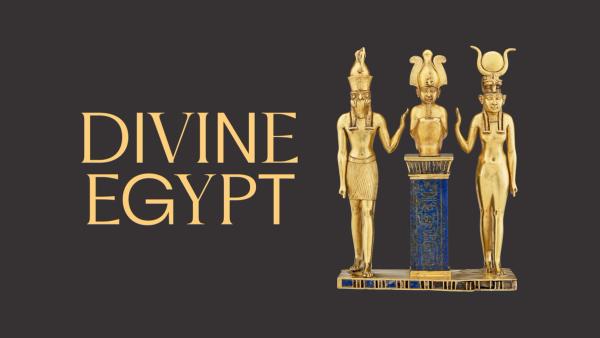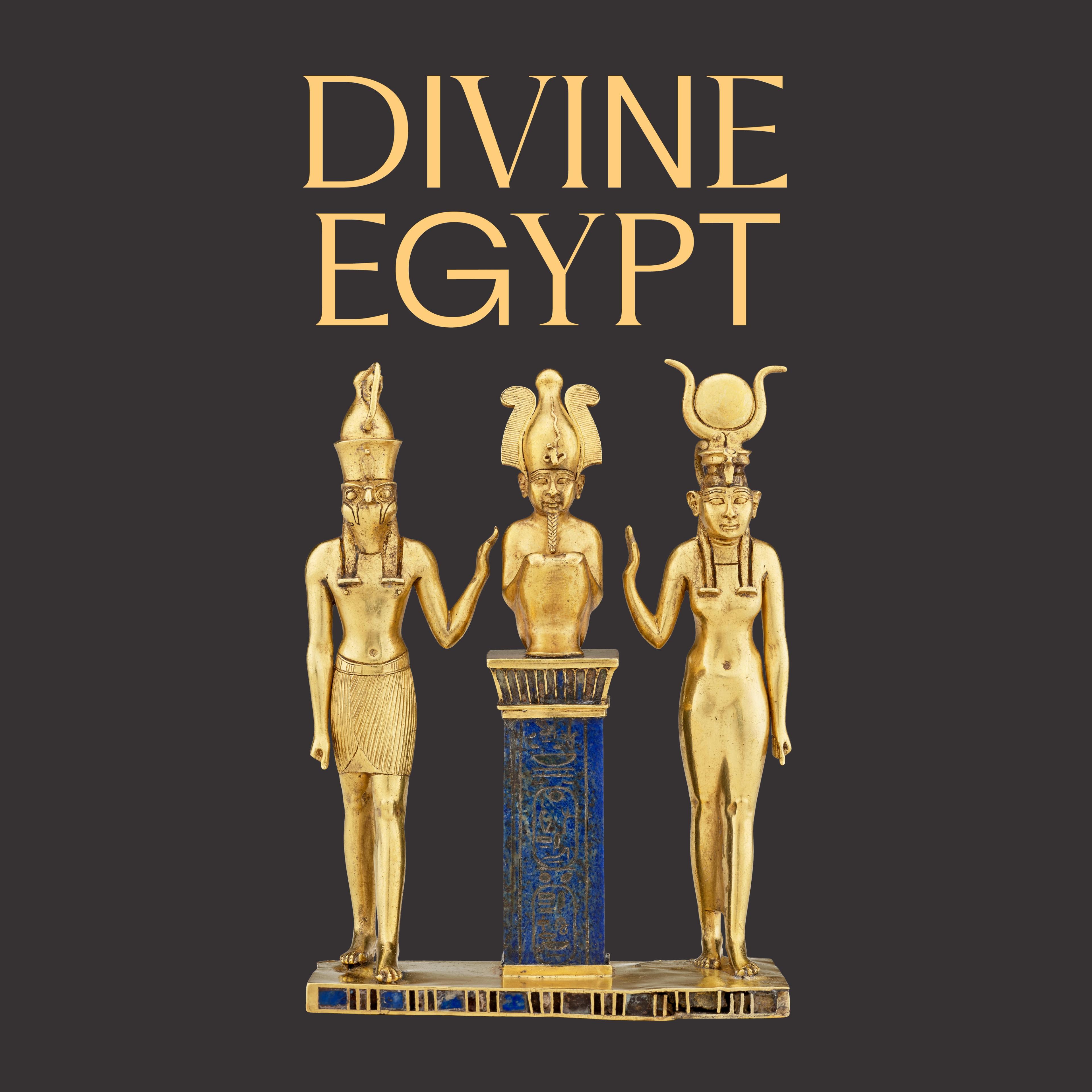Audio Guide
Meet the gods of ancient Egypt.

600. Introduction
Welcome to Divine Egypt.
DIANA CRAIG PATCH: Ancient Egypt is one of the most recognizable ancient cultures.
NARRATOR: From the pyramids of Giza to Hollywood films, ancient Egyptian imagery saturates our modern world. But under the surface lies an extraordinarily sophisticated and complex culture.
Diana Craig Patch is the Lila Acheson Wallace Curator in Charge of the Department of Egyptian Art at The Met. She’s the curator of this exhibition.
PATCH: Ancient Egyptian culture lasted for 4500 years…
The Egyptians’ approach to the divine landscape was additive. They didn’t drop deities, but they added new ones as they needed them.
So the result is, by 300 BCE, you had some 1500 deities in the ancient Egyptian belief system.
NARRATOR: Sometimes multiple gods could be represented in the same way. Sometimes a single god could take multiple forms. But they all had a role to play in the lives of Pharaohs and everyday Egyptians.
PATCH: The ancient Egyptians used their religious beliefs, their gods, to tackle life's challenges, to cope with life. They needed to deal just like we do today with health, childbirth, children, love, jobs. All the stuff that we worry about.
NARRATOR: You’ll meet just a few of these many gods and goddesses on your visit today. Diana and her colleagues from The Met’s Department of Egyptian Art will be your guides as you discover the identities of these ancient deities and explore their fascinating world.
Welcome to Divine Egypt!
This Audio Guide is sponsored by Bloomberg Philanthropies.
Playlist
Diana Craig Patch
Diana Craig Patch specializes in the art and archaeology of ancient Egypt, receiving her PhD from the University of Pennsylvania with a dissertation on settlement patterns and early state development. She curated The Dawn of Egyptian Art (2012), exploring the contributions of Predynastic art to Pharaonic culture, and Cleopatra's Needle (2013–14), celebrating the Central Park icon. In 2017–18, she co-curated Jewelry: The Body Transformed. She also co-curated the reinstallation of the Predynastic and Early Dynastic gallery (2003). Patch teaches and lectures frequently. She has carried out extensive fieldwork in Egypt, and directs the Joint Expedition to Malqata (2008–19), the festival-city of Amenhotep III in Thebes.
Academia.edu: Publications by Diana Craig Patch
MetPublications: Selected publications by Diana Craig Patch
Brendan Hainline
Brendan Hainline joined the department in October of 2023 as a Research Associate working on an upcoming exhibition. Before joining The Met, Brendan worked as a Teaching Fellow at the University of Chicago, and he has participated in excavations in Egypt at Giza and Tell Edfu. His research focuses on Egyptian language and texts, Old Kingdom religion, and linguistic and cultural contacts between ancient Egypt and its neighbors, and his forthcoming book is a study of linguistic variation in the Old Kingdom Pyramid Texts. He earned his PhD from the University of Chicago in 2020.
Adela Oppenheim
Adela Oppenheim received her BA from New York University, MA from the University of Pennsylvania, and PhD from the Institute of Fine Arts with a dissertation on the decorative program of the Senwosret III pyramid temple at Dahshur. She co-directs the Met’s excavations at the Middle Kingdom pyramid complex of Senwosret III (with curator emeritus Dieter Arnold), where her work focuses on the fragmentary relief decoration and sculpture of the king’s temples. Adela has written and lectured extensively on Middle Kingdom art and the results of the Dahshur excavations. She was co-curator of the 2015–16 exhibition Ancient Egypt Transformed: The Middle Kingdom. Currently she is working on the reliefs and models from the Theban tomb of Meketre.
Oppenheim, Adela. “The Early Life of Pharaoh: Divine Birth and Adolescence Scenes in the Causeway of Senwosret III at Dahshur.” In Abusir and Saqqara in the Year 2010, edited by Miroslav Bárta, Filip Coppens, and Jaromír Krejčí, 171–88. Prague: Czech Institute of Egyptology, Faculty of Arts, Charles University in Prague, 2011.
Academia.edu: Publications by Adela Oppenheim
MetPublications: Selected publications by Adela Oppenheim
Isabel Stünkel
Isabel Stünkel is an Egyptologist who holds an MA and PhD from the University of Bonn. Before joining The Met, she was the founding curator of the Egyptian Museum of the University of Bonn. Isabel is a member of The Met's excavation at the pyramid complex of Senwosret III at Dahshur, where she is working on the decoration of the royal women's chapels. Among her research interests are amulets, especially their religious significance and function, and general questions regarding human remains in museum settings. Isabel is Egyptian Art’s departmental liaison with our colleagues in Education.
Stünkel, Isabel. “The Decoration of the North Chapel of Khenemetneferhedjet Weret I at Dahshur.” PhD. diss., Rheinische Friedrich-Wilhelms-Universität zu Bonn, 2018.
———. “An Amulet Plaque and a Book of the Dead Papyrus from The Metropolitan Museum of Art and Some Observations on Gold Amulets.” In Weitergabe: Festschrift für Ursula Rößler-Köhler zum 65. Geburtstag, edited by Ludwig D. Morenz and Amr El Hawary. Göttinger Orientforschungen IV, Reihe Ägypten, 407–427. Wiesbaden: Harrassowitz, 2015.
Smyth, Andrew W., Patrick Brewick, Raphael Greenbaum, Manolis Chatzis, Anna Serotta, and Isabel Stünkel. “Vibration Mitigation and Monitoring: A Case Study of Construction in a Museum.” Journal of the American Institute of Conservation 55, no. 1 (2016): 32–55.
Niv Allon
Niv Allon received his PhD in Egyptology from Yale University in 2014. That same year, he joined the Museum's curatorial staff as a specialist in ancient Egyptian texts and scripts. His scholarship probes the nexus of visual studies and textual analysis by investigating how art, sign, and language interact. More recently, he has focused on representations of violence in text and art, while preparing a publication on the jar labels from the festival-city of Amenhotep III at Malqata.
Allon, Niv. “War and Order in Eighteenth Dynasty Egypt (1550-1295 BCE),” Zeitschrift für ägyptische Sprache und Altertumskunde, forthcoming.
———. Writing, Violence and the Military: Images of Literacies at the time of Haremhab (1550-1295 BCE). Oxford: Oxford University Press, 2019.
———, and Hana Navratilova. Ancient Egyptian Scribes: A Cultural Exploration. London: Bloomsbury Publishing PLC, 2017.
Academia.edu: Publications by Niv Allon
Aude Semat
Aude Semat joined the Department in October 2019 and oversees the Second Intermediate Period and early New Kingdom galleries, as well as the Department’s archives. Aude studied art history and Egyptology at the École du Louvre and the Sorbonne, receiving her PhD in Egyptology in 2017. She has taken part in exhibitions and cataloguing projects in museums in France and the US, and taught at the École du Louvre until 2018. Her research focuses on tomb architecture and painting, landscape, and gardens, as well as the history of collecting and museums in the nineteenth century. Aude is currently preparing a book on architectural painting and landscape in ancient Egyptian art, and studying the collection of the first Egyptian museum in Russia.
Semat, Aude. “The Mummy and the Coffin as Images of the Deceased in Ancient Egyptian Imagery.” In Proceedings of the Second Vatican Coffin Conference (June 6-9, 2017), edited by Alessia Amenti. Vatican: Musei Vaticani, forthcoming.
———. “Images of Power, Powerful Images: Depicting the King in Ancient Egypt.” In Pharaoh, King of Ancient Egypt, edited by Marie Vandenbeusch, Aude Semat, and Margaret Maitland, 24–31. New Haven/London: Yale University Press, 2016.
———. “Les caractéristiques du dessin égyptien” and “L’idée du beau dans l’Égypte ancienne.” In Dossiers d’archéologie, Hors série n°1 Le dessin dans l’Égypte ancienne (April 2013): 4–7 and 32–37.
Janice Kamrin
Janice Kamrin holds a BA from Bryn Mawr College and a PhD from the University of Pennsylvania. Her research interests include Middle Kingdom tomb art, the archaeology of Thebes, and the funerary arts of the first millennium. In the Department, she oversees matters related to The Museum System (TMS) and technology in general. She is a member of the Joint Expedition to Malqata, the festival city of Amenhotep III, and is working on projects related to the archives of The Met’s early 20th Century Egyptian Expedition. Before coming to The Met, Janice directed several projects at the Egyptian Museum, Cairo, for the American Research Center in Egypt and worked closely with Zahi Hawass, former head of the antiquities service. She is on the board of the American Research Center in Egypt.
Kamrin, Janice, and Yasmin El Shazly. “The coffins of Imhotep (Imuthes of Meir).” In The Book of the Dead, Saite through Ptolemaic Periods: Essays on Books of the Dead and Related Materials, edited by Malcolm Mosher, Jr., 171–240. Prescott, AZ: Malcolm Mosher Jr. 2019.
———. “The Egyptian Museum Database, Digitizing, and Registrar Training Projects: Update 2009.” In The Art and Culture of Ancient Egypt: Papers in Honor of Dorothea Arnold (Bulletin of the Egyptological Seminar 19), edited by Ogden Goelet and Adela Oppenheim. New York: Egyptological Seminar of New York, 2015.
———. The Cosmos of Khnumhotep II at Beni Hasan. New York: Kegan Paul International, 1999.
